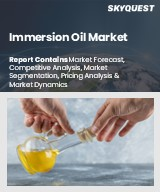
세계의 침지 오일 시장 규모는 2023년에 28억 달러로 평가되었고, 2024년 29억 6,000만 달러에서 2032년에는 46억 5,000만 달러로 성장하며 예측 기간(2025-2032년)의 CAGR은 5.8%를 나타낼 전망입니다.
세계의 침지 오일 시장은 현미경 검사에서 고해상도 이미징을 실현하는 데 필수적이며, 특히 빛의 굴절을 줄이고 광학 투명성을 높일 수 있습니다. 그 용도는 생물의학 연구, 임상 진단, 생명 과학, 공업 환경에서의 품질 검사 등 다양한 분야 및 모두 정밀한 이미징이 필요합니다. 아시아태평양 수요는 유전체학와 창약의 진보가 견인하고 있으며, 북미는 헬스케어와 바이오테크놀러지 부문이 강하기 때문에 뒤를 이었습니다. 유럽에서도 연구·산업실에서의 이용이 눈에 띄고 있습니다. 합성유와 저점도의 몰입 오일의 끊임없는 기술 혁신은 안정성과 첨단 광학계의 적합성을 높여 나노테크놀로지나 반도체 검사에의 용도를 확대하고 있습니다. 디지털 이미징을 대체하는 비용면에서의 압력에도 불구하고, 몰입 오일의 탁월한 정밀도는 향후 지속적인 관련성을 보장합니다.
Global Immersion Oil Market size was valued at USD 2.8 billion in 2023 and is poised to grow from USD 2.96 billion in 2024 to USD 4.65 billion by 2032, growing at a CAGR of 5.8% during the forecast period (2025-2032).
The global immersion oil market is essential for achieving high-resolution imaging in microscopy, particularly in reducing light refraction and enhancing optical clarity. Its applications span various fields including biomedical research, clinical diagnostics, life sciences, and quality inspection in industrial settings, all of which require precise imaging. Demand in the Asia-Pacific region is driven by advancements in genomics and drug discovery, with North America following closely due to its strong healthcare and biotechnology sectors. Europe also sees significant utilization in research and industrial labs. Continuous innovation in synthetic and low-viscosity immersion oils enhances stability and compatibility with advanced optics, while expanding their applications into nanotechnology and semiconductor inspections. Despite cost pressures from digital imaging alternatives, immersion oils' unmatched accuracy ensures their sustained relevance in the future.
Top-down and bottom-up approaches were used to estimate and validate the size of the Global Immersion Oil market and to estimate the size of various other dependent submarkets. The research methodology used to estimate the market size includes the following details: The key players in the market were identified through secondary research, and their market shares in the respective regions were determined through primary and secondary research. This entire procedure includes the study of the annual and financial reports of the top market players and extensive interviews for key insights from industry leaders such as CEOs, VPs, directors, and marketing executives. All percentage shares split, and breakdowns were determined using secondary sources and verified through Primary sources. All possible parameters that affect the markets covered in this research study have been accounted for, viewed in extensive detail, verified through primary research, and analyzed to get the final quantitative and qualitative data.
Global Immersion Oil Market Segments Analysis
Global Immersion Oil Market is segmented by Product Type, Application, End-User, Refractive Index and region. Based on Product Type, the market is segmented into Type A (Low Viscosity), Type B (Medium Viscosity), Type F (Fluorescence) and Type C (High Viscosity). Based on Application, the market is segmented into Microscopy, Refractometry, Optical Sensors and Scientific Research. Based on End-User, the market is segmented into Hospitals & Diagnostic Laboratories, Pharmaceutical & Biotechnology Companies, Academic & Research Institutes and Industrial. Based on Refractive Index, the market is segmented into 1.515, 1.518 and Others. Based on region, the market is segmented into North America, Europe, Asia Pacific, Latin America and Middle East & Africa.
Driver of the Global Immersion Oil Market
A significant driver of the global immersion oil market is the escalating investment in biotechnology, academic life sciences research, and pharmaceutical R&D. These sectors are crucial for advancing microscopy technologies, where high-resolution imaging often requires premium-quality immersion oil. Additionally, the increasing funding from government and private institutions for research in genetics and cancer further amplifies the demand for sophisticated imaging consumables. The flourishing activity in research and development within these fields directly contributes to the growth of the global immersion oil market, highlighting the essential role of high-quality products in achieving reliable and precise imaging results.
Restraints in the Global Immersion Oil Market
The high expense of Low-autofluorescence Type F oil, which is essential for fluorescence microscopy, poses a significant barrier to growth in the global immersion oil market. This premium oil is considerably more expensive than regular varieties, making it challenging for university research laboratories and smaller diagnostic facilities operating with tight budgets. Consequently, many of these institutions find themselves constrained in their ability to acquire sufficient quantities of this vital consumable. As a result, these financial hurdles hinder research capabilities and limit the market's expansion potential, presenting a notable restraint within the industry.
Market Trends of the Global Immersion Oil Market
The global immersion oil market is experiencing significant growth, driven by the escalating adoption of advanced fluorescence microscopy in various research and diagnostic applications, particularly in oncology. The demand for high-quality immersion oils with low-autofluorescence properties and minimal background interference is surging as researchers seek enhanced imaging clarity for genetic testing and cancer diagnostics. This trend highlights the increasing reliance on specialized oils, such as Type F, which are designed to optimize imaging performance and accuracy. As the scientific community continues to prioritize precision and reliability in microscopy, immersion oil remains a crucial component, propelling market expansion and innovation.